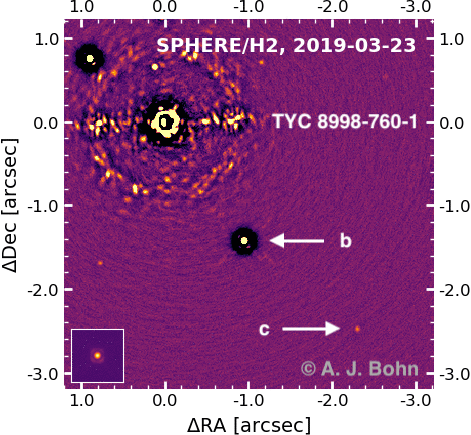3 min read

The planet: TYC 8998-760-1 c
The discovery: This hot, very large planet is the second to be directly imaged – that is, pixels of light captured by telescope from the planet itself – as it orbits a Sun-like star some 300 light-years away. An international team of scientists published its discovery of the star's first directly imaged companion in February 2020.
Key facts: These two planets – TYC 8998-760-1 b and now, c – are considered the first multi-planet system to be directly imaged around a Sun-like star. The star is a baby version of our Sun, only 17 million years old. The extreme youth of this system is a big part of why astronomers were able to capture direct images: The planets are so hot from their recent formation that they still glow brightly enough to be seen from our vantage point, even though they're hundreds of light-years away.
Details: Planets b and c are much farther away from their star than, say, Jupiter and Saturn are from the Sun. Planet b is 160 times the Earth-Sun distance, planet c is about 320 times. Just for comparison, Jupiter is 5 times the Earth-Sun distance, Saturn 10 times.
And these planets are bruisers. The inner planet, b, is about 14 times the mass, or heft, of Jupiter, c about 6 times. Planet b, in fact, might even be a brown dwarf, a kind of failed star considered neither a star nor a planet, but somewhere in between.

Fun facts: Thousands of planets around other stars – exoplanets – have been confirmed so far in our galaxy, which likely holds trillions. But the vast majority are found through indirect means – measuring wobbles in the star's motion caused by the gravity of orbiting planets, or the tiny dip in starlight as a planet crosses its star's face. Only a few dozen of the exoplanets found so far have been directly imaged. And direct images of multi-planet systems are rarer still: only two others so far, both with stars very different from our Sun. The new system, with its Sun-like star, might have some characteristics in common with the very early history of our own solar system. It offers an exciting opportunity for scientists to learn more about the formation of such systems, including our own.
The discoverers: Both planets in this system were discovered by an international team of scientists led by Alexander J. Bohn of Leiden University in the Netherlands. They used the SPHERE instrument on the Very Large Telescope (VLT) at the European Southern Observatory in Chile to observe the star and its planets in February 2020. The planet was entered into NASA's Exoplanet Archive on July 23.







